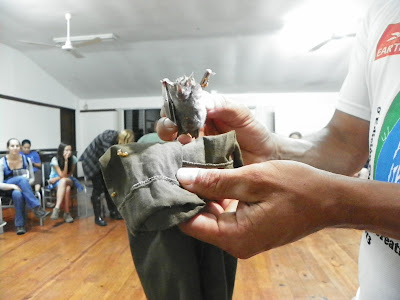Day 7
Day seven started with a breakfast and a student facilitated
group team building activity.
Today's lecture and information provided below by Carlos Chavarria:
ENVIRONMENTAL IMPACTS OF
TOURISM
Tourism can have a variety of negative impacts on
biodiversity, particularly when carried out without
management standards designed to protect natural assets.
Infrastructure / facilities: Tourism development usually requires some form of infrastructure, which can result in significant alteration or destruction of natural habitats.
Resource depletion: Tourism development may concentrate local resource use in smaller areas and / or undermine local resource management systems.
Water pollution: New infrastructure developments often lead to increased sewerage pollution. This can have severe nega4ve impacts on coastal biodiversity, par4cularly in areas with coral reefs.
Infrastructure / facilities: Tourism development usually requires some form of infrastructure, which can result in significant alteration or destruction of natural habitats.
Resource depletion: Tourism development may concentrate local resource use in smaller areas and / or undermine local resource management systems.
Water pollution: New infrastructure developments often lead to increased sewerage pollution. This can have severe nega4ve impacts on coastal biodiversity, par4cularly in areas with coral reefs.
The tourism industry is dependent on the healthy
production of a wide variety of ecosystem services.
Tourist activities in coastal areas often focus on diverse marine resources such as coral reefs, whales, and bird life, and require clean water for ac4vi4es such as swimming and scuba diving.
National parks are open located in forested and mountainous areas and rely on the services of ecosystems to provide visitors with recreational, educational, and cultural experiences.
Tourist activities in coastal areas often focus on diverse marine resources such as coral reefs, whales, and bird life, and require clean water for ac4vi4es such as swimming and scuba diving.
National parks are open located in forested and mountainous areas and rely on the services of ecosystems to provide visitors with recreational, educational, and cultural experiences.
CERTIFICATIONS FOR SUSTAINABLE TOURISM
The development of sustainable tourism must be seen as the balanced interaction
between the use of our natural and cultural resources, the improvement of the
quality of life among the local communities, and the economic success of the industry, which also contributes to national development. Sustainable tourism is not only a response to demand, but also an imperative condition to successfully compete now and in the future. (Definition of Sustainable Tourism, CST, 1997)
quality of life among the local communities, and the economic success of the industry, which also contributes to national development. Sustainable tourism is not only a response to demand, but also an imperative condition to successfully compete now and in the future. (Definition of Sustainable Tourism, CST, 1997)
La Quinta is an eco-lodge nationally certified by the Costa Rican Tourists Board with its Certification for Sustainable Tourism (CST). La Quinta has 5 Leaves level, being 5 Leaves the maximum qualification. The CST is a comprehensive program that categorizes and certifies each tourism company to the degree they comply with the model of sustainable tourism.La Quinta strives to have little, to no negative impact on its immediate environment. Every effort is taken to co-exist harmoniously with our surroundings. Our ten acres are composed of regenerating agriculture, a reforested area with native trees, an old-growth forest on the riverside and tropical gardens
Here are some pictures from the tour of the property and the many plants and animals we saw as well as bat demonstration:
For more photos and information : https://www.facebook.com/douglas.stuchel/media_set?set=a.10201003539264411.1073741828.1044914656&type=3

































































No comments:
Post a Comment